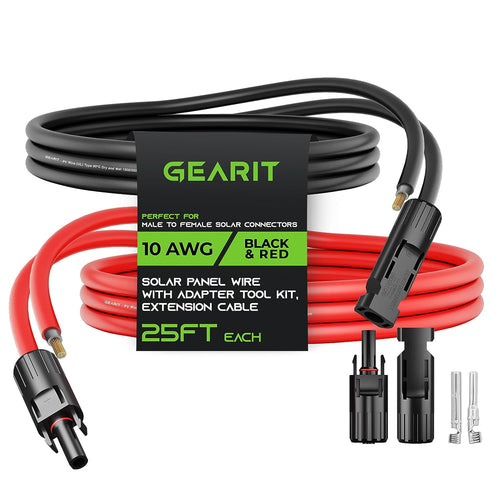
Why Solar Panel Extension Cables Matter
Solar panel extension cables play a crucial role in connecting your solar panels to various components of your solar power system, such as charge controllers, batteries, and inverters. They allow you to:
• Increase Flexibility: Position your solar panels in optimal locations to capture the most sunlight, even if those locations are far from your main setup.
• Reduce Cable Resistance: Use appropriate cable lengths and thicknesses to minimize power loss due to resistance, ensuring maximum efficiency.
• Enhance Safety: Properly rated cables reduce the risk of overheating and electrical fires.
Choosing the Right Solar Panel Extension Cable
When selecting a solar panel extension cable, consider the following factors:
• Cable Type: There are several types of cables used in solar power systems, but the most common are:
• MC4 Cables: These are widely used due to their compatibility with most solar panels and ease of installation.
• SAE Cables: Often used in smaller setups, such as RVs and portable solar kits.
Cable Length
The length of the cable affects both the efficiency and the practicality of your solar power system. Here are some tips for choosing the right length:
• Measure Distance: Determine the distance between your solar panels and the main components of your system.
• Minimize Length: Use the shortest cable length possible to reduce power loss due to resistance.
Cable Gauge
The gauge (thickness) of the cable is crucial for ensuring that it can handle the current without overheating. Here are some guidelines:
• Thicker Cables for Longer Runs: If you need longer cables, opt for a lower auge (thicker) cable to handle the increased current and reduce resistance.
• Consult Specifications: Check the specifications of your solar panels and components to determine the appropriate gauge.
Weather Resistance
Since solar panel extension cables are often exposed to the elements, it’s important to choose cables that are:
• UV Resistant: To withstand prolonged exposure to sunlight.
• Waterproof: To protect against rain and moisture.
• Temperature Resistant: To handle extreme temperatures, both hot and cold.
Installation Tips
Proper installation of solar panel extension cables is key to a safe and efficient solar power system. Follow these steps for a successful setup:
1. Plan Your Layout: Before you begin, plan the layout of your solar panels and components. Consider the optimal placement for sunlight exposure and the most efficient cable routing.
2. Secure Connections: Ensure all connections are secure and properly tightened. Loose connections can lead to power loss and potential safety hazards.
3. Avoid Sharp Bends: Prevent sharp bends in the cables, as these can damage the insulation and conductors, leading to short circuits or reduced efficiency.
4. Protect from Physical Damage: Use cable clips, conduits, or protective tubing to shield the cables from physical damage, such as abrasion or crushing.
5. Test the System: After installation, test the system to ensure that all components are functioning correctly and that there is no power loss or overheating.
6. Maintenance Practices: Regular maintenance of your solar panel extension cables ensures long-term performance and safety. Here are some maintenance tips:
- Inspect Regularly: Conduct visual inspections of the cables and connections at least once a year. Look for signs of wear, damage, or corrosion.
- Clean Connections: Keep connections clean and free of dirt, debris, and corrosion. Use a soft cloth and contact cleaner if necessary.
- Monitor Performance: Track the performance of your solar power system. Sudden drops in efficiency may indicate an issue with the cables or connections.
- Replace When Necessary: If you notice any damage or wear that could affect the performance or safety of the cables, replace them immediately.
Conclusion
Solar panel extension cables are an essential component of any solar power system, providing the flexibility and efficiency needed to harness the power of the sun effectively. By choosing the right cables, following proper installation practices, and maintaining your system regularly, you can ensure optimal performance and longevity of your solar power setup. Embrace the power of renewable energy and enjoy the benefits of a well-maintained solar system, whether at home or on the go.




















































